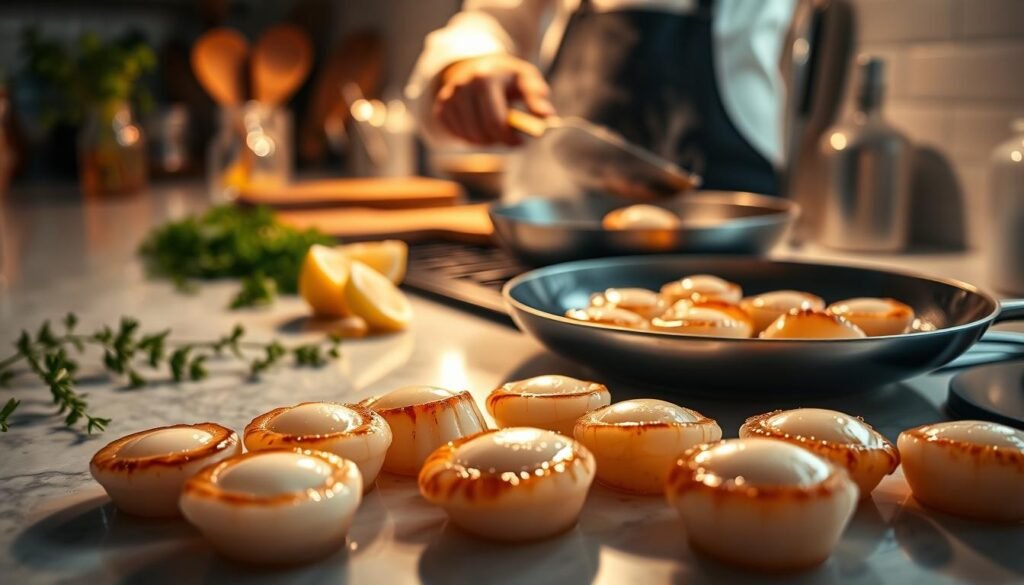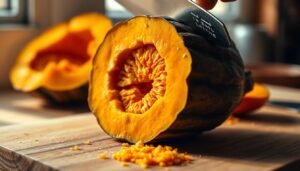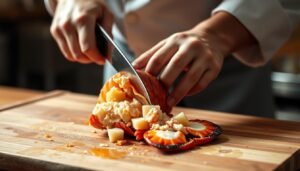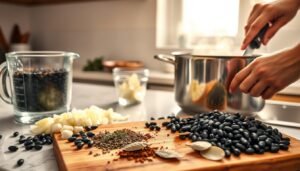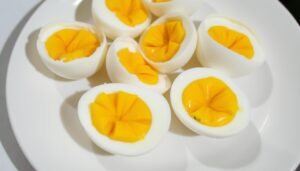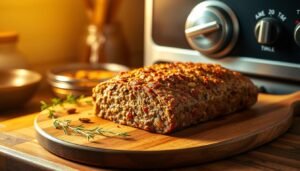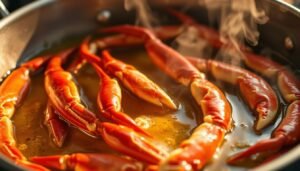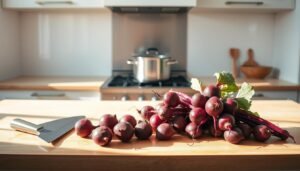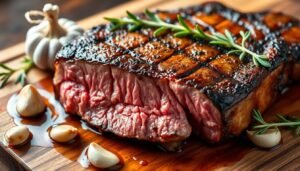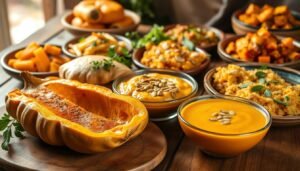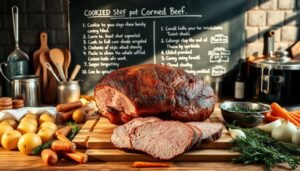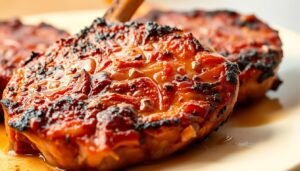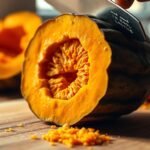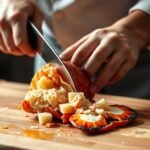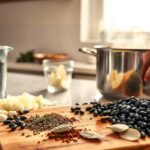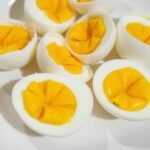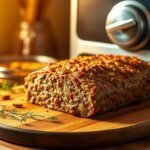Did you know scallops are a top seafood choice in the U.S.? Americans eat about 80 million pounds each year. If you want to cook scallops and wow your loved ones, you’re in the right spot! This guide will teach you the basics of cooking scallops, making your meals a hit. You’ll learn about scallop taste, texture, and cooking methods, plus get some tasty recipes and tips.
Key Takeaways
- Scallops are a popular seafood choice in the U.S., with millions of pounds consumed annually.
- Understanding the taste and texture of scallops is crucial for successful cooking.
- Proper selection of scallops, whether fresh or frozen, can greatly affect the quality of your dish.
- Simple preparation techniques can enhance flavor and texture in your scallop dishes.
- Mastering different cooking methods, like searing and grilling, is essential for the perfect scallop.
- Implementing complementary flavors and sauces can elevate your scallop recipes to new heights.
Introduction to Scallops: Taste and Texture
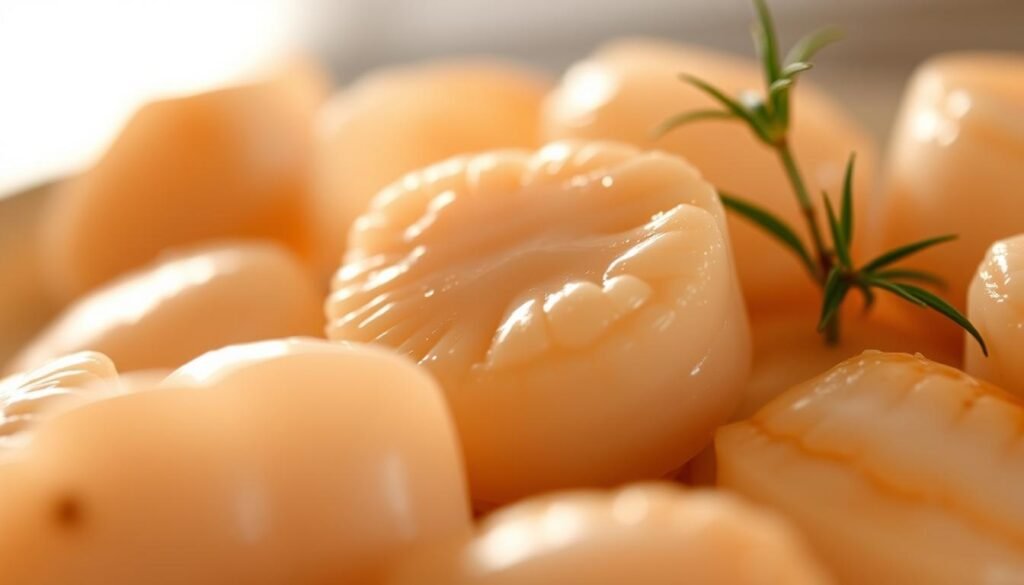
Scallops are a tasty seafood choice known for their unique flavor and texture. They have a sweet, delicate taste that shines when cooked right. Their springy texture makes them a great addition to many dishes.
Knowing the different scallops types can make your cooking better. It lets you pick the perfect scallops for your recipes.
What Are Scallops?
Scallops are part of a family of bivalve mollusks with two-part shells. We eat the adductor muscle, which is the tasty part. Fresh scallops are moist and shiny, showing they’re good to eat.
Many love scallops because they soak up flavors well. Yet, they keep their own special taste.
Types of Scallops
There are many scallops types, each with its own flavor and size. Here’s a quick look at the most common ones:
| Type of Scallop | Size | Taste Profile | Best Cooking Methods |
|---|---|---|---|
| Sea Scallops | Large | Rich and sweet | Searing, grilling |
| Bay Scallops | Small | Sweet and tender | Quick sauté, salads |
| King Scallops | Very large | Buttery flavor | Broiling, baking |
| Diver Scallops | Varied | Clean and fresh | Searing, poaching |
Exploring these scallops types helps me choose the best for my cooking. It makes my dishes taste and feel better. Cooking with scallops is more fun when I know their special traits.
Choosing the Right Scallops
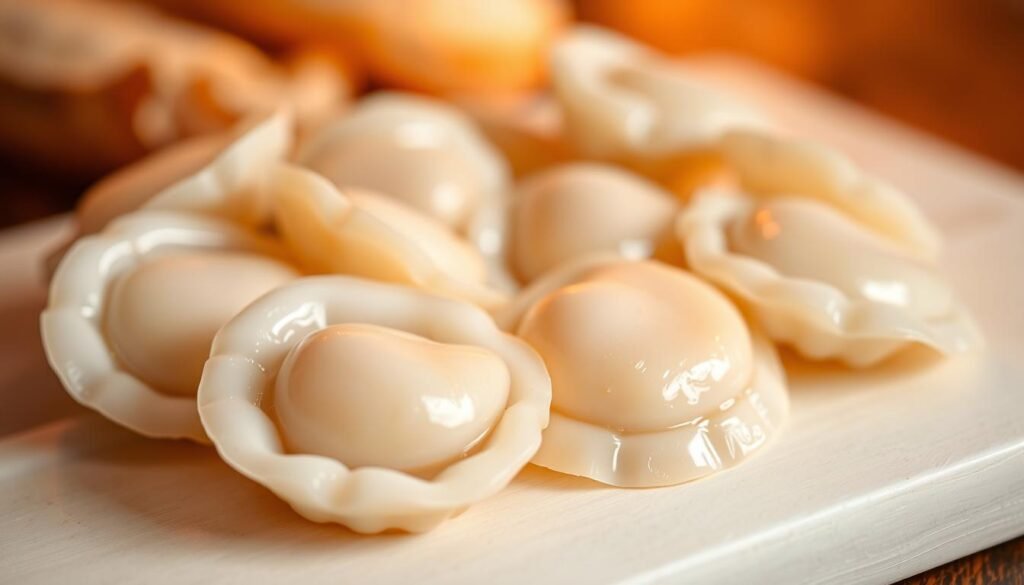
At the seafood market, I often think about fresh scallops versus frozen ones. Each has its own benefits. Knowing which to pick can really make a difference in my dish’s taste.
Fresh vs. Frozen Scallops
Fresh scallops are firm and have a sweet smell, making any meal better. Frozen scallops, though easy to find, might not taste as good. If I choose frozen, I look for dry-packed ones. These haven’t been preserved, so they cook well and taste great.
Tips for Selecting Scallops at the Market
When picking scallops, I follow some simple rules:
- Choose scallops that are white and shiny, showing they’re fresh.
- Stay away from scallops that are off-color or smell too fishy.
- Ask about the scallops’ harvesting to ensure they’re sustainable.
Sustainable Seafood Choices
For me, choosing eco-friendly seafood is key. I often go for Diver Scallops, which are better for the ocean. These choices help the environment and let me enjoy quality seafood that fits my values.
Preparation Techniques for Scallops
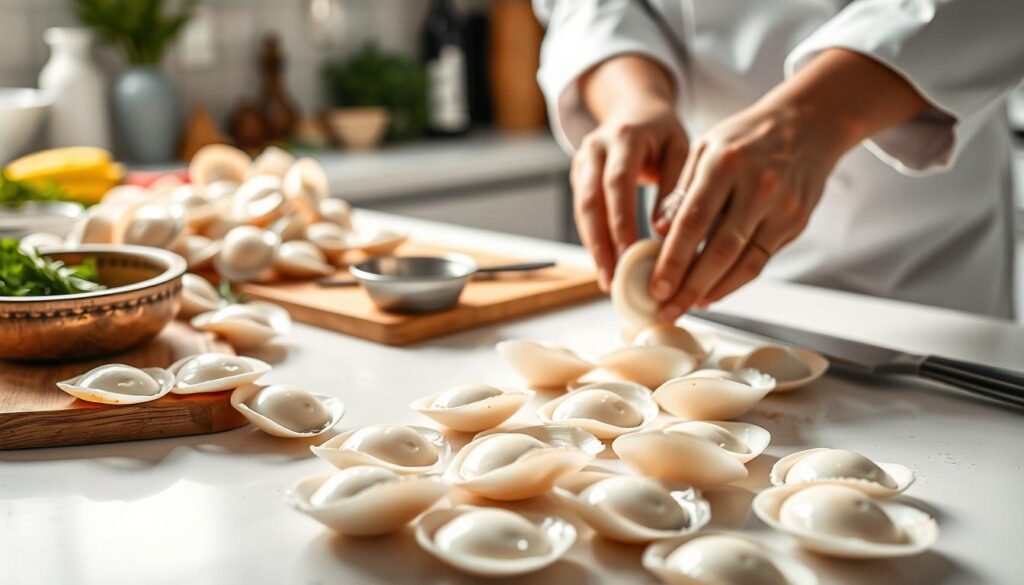
Getting your scallops ready right is key for great taste and texture. Learning how to clean and marinate them can really boost your dish. Let’s explore the best ways to prepare scallops.
Cleaning and Drying Scallops
Start by removing the small side muscle from the scallops. This muscle can be tough and affect the flavor. Next, dry the scallops well with paper towels.You can learn about how to cook ground beef.
This step helps get a nice sear when cooking. It also stops extra moisture from weakening the flavors. If you can, chill the scallops for a bit to dry them better.
Marinating Scallops for Flavor
Marinating scallops can really improve their taste. I choose simple mixes with olive oil, citrus, and herbs. These ingredients blend well, letting the scallops’ natural sweetness come out.
Just 30 minutes to an hour in the marinade can change the taste a lot.
| Preparation Technique | Description |
|---|---|
| Cleaning Scallops | Remove the side muscle and dry thoroughly with paper towels. |
| Marinating Scallops | Soak in an olive oil-based mixture with herbs or citrus for enhanced flavor. |
Cooking Methods for Scallops
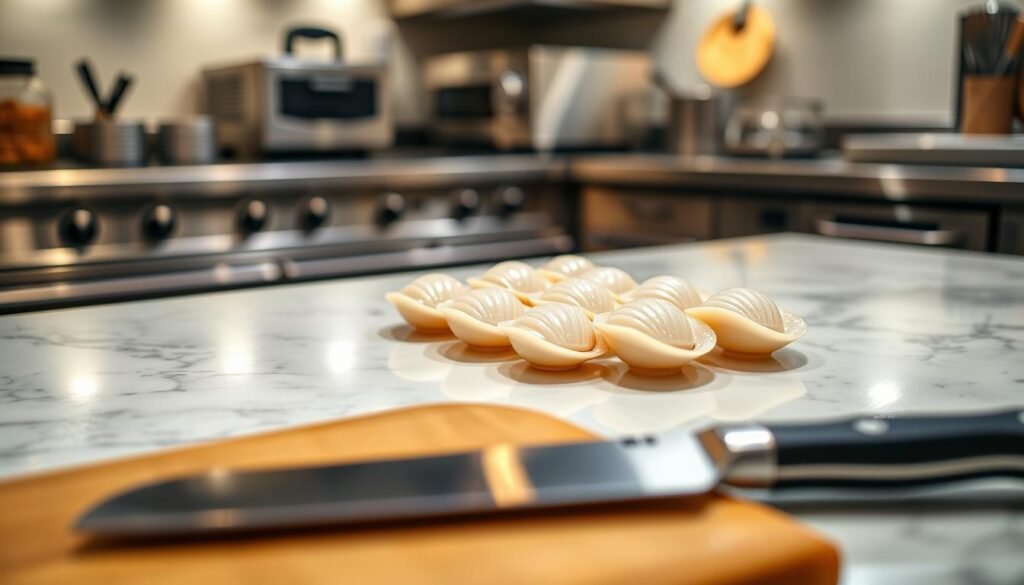
Learning how to cook scallops opens up a world of tasty options. Searing scallops is my top choice because it creates a golden crust and keeps them moist inside. Grilling adds a smoky flavor, perfect for summer. Baking scallops is easy and delicious, great with breadcrumbs and herbs.
Searing Scallops to Perfection
Searing scallops means cooking them fast in a hot pan. My trick is to preheat the pan and dry the scallops before cooking. A little oil helps get that perfect sear. Cook for 2-3 minutes on each side until they’re golden.
Grilling Scallops for a Smoky Flavor
Grilling scallops outdoors is my favorite. It adds a smoky taste that makes them even sweeter. Marinate them in herbs and spices for extra flavor. Grill for 2-3 minutes on each side. It’s great for summer and makes any meal festive.
Baking Scallops in the Oven
Baking scallops is simple and brings out their rich flavors. Mix them with breadcrumbs, Parmesan, and herbs, then bake. Bake at 350°F for 15-20 minutes until they’re cooked and golden. It’s elegant and keeps them tender.You can learn about how to cook broccoli.
Flavor Pairings with Scallops
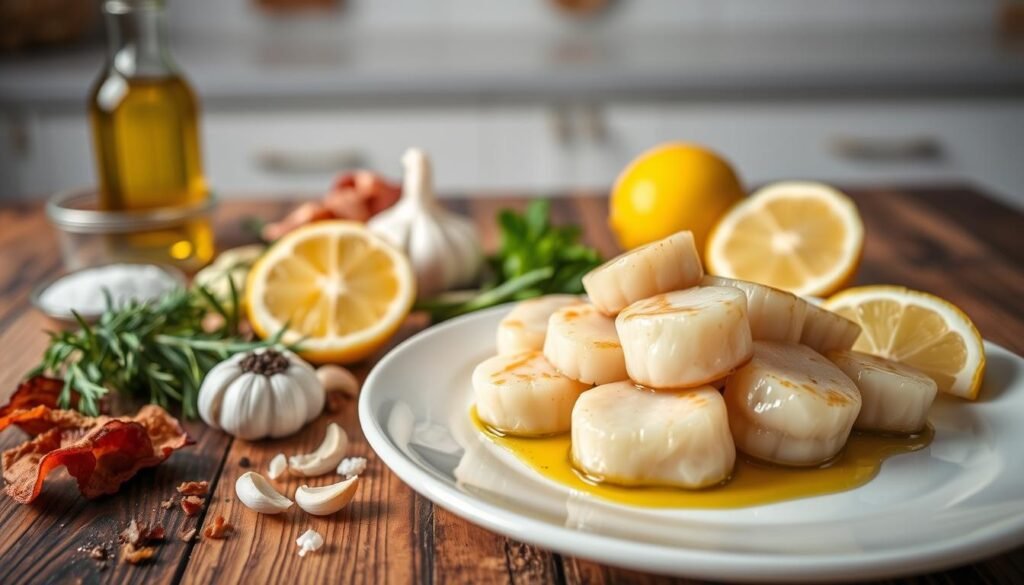
Finding the right scallop flavor pairings can make your dish stand out. Adding delicious herbs to scallops not only boosts their taste but also adds a nice aroma. Whether you prefer a light or bold flavor, these suggestions will enhance the scallops’ oceanic taste.
Best Herbs and Spices for Scallops
Herbs are key when cooking scallops. Fresh thyme, rosemary, and tarragon are great because they complement scallops’ sweet flavor. You can chop these herbs finely and mix them into marinades or sprinkle them on while cooking.
Parsley and chives add a fresh contrast to scallops’ richness. They make the dish more interesting.
Sauces That Complement Scallops
Choosing the right sauce can elevate your scallop dish. A lemon beurre blanc is a classic choice, adding a creamy and tangy taste. Herb-infused oils are a lighter option, letting scallops’ natural sweetness shine.
Pairing scallops with crispy bacon or sweet corn adds depth to the flavors. For more tips on enhancing your scallop dishes, check out this guide on scallop pairings.
| Herbs and Spices | Flavor Profile | Usage |
|---|---|---|
| Thyme | Earthy and fragrant | Great for marinades and garnishes |
| Rosemary | Pine-like and aromatic | Perfect for grilling |
| Tarragon | Sweet and anise-like | Ideal for creamy sauces |
| Parsley | Fresh and vibrant | Use as a garnish or in salads |
| Chives | Mild onion flavor | Sprinkle fresh on top for color |
With these herbs and sauces, every dish becomes a new adventure. Try these pairings to find your favorite flavors.
Scallop Recipes for Every Occasion
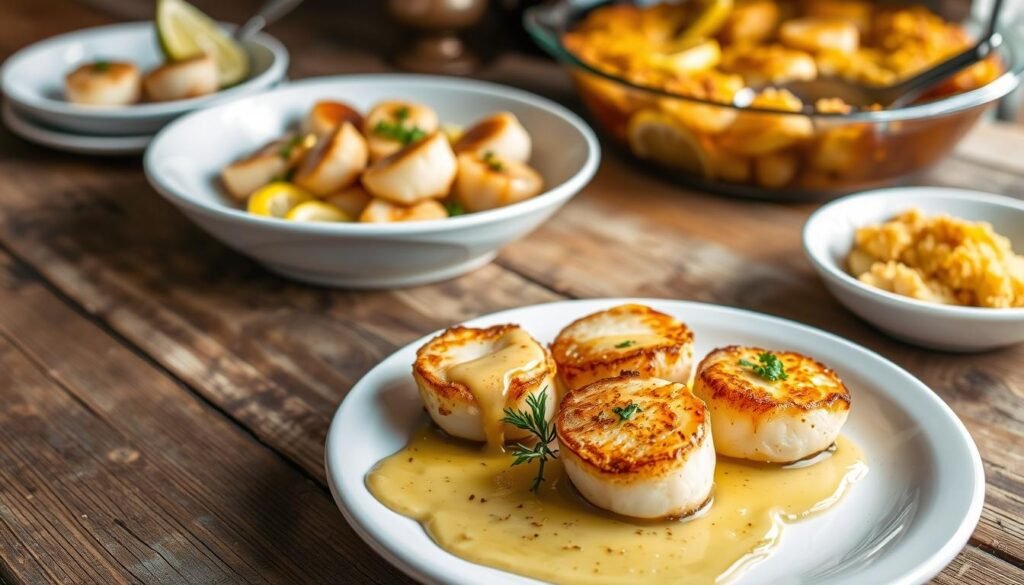
Scallops are a versatile seafood that can make any meal special. They add a touch of elegance to both casual and formal dishes. I enjoy trying out different scallop recipes to highlight their delicate taste and texture.
Classic Garlic Butter Scallops Recipe
The classic garlic butter scallops are a favorite of mine. This dish brings out the sweet and buttery taste of scallops, enhanced by the aroma of garlic. I cook the scallops until they’re golden, then serve them with a rich garlic butter sauce. It’s a main course that always gets rave reviews.
Scallops with Lemon and Capers
Scallops with lemon and capers offer a lighter option. The zesty lemon sauce makes the scallops even sweeter. Capers add a tangy twist, making it perfect for summer. It’s great with a salad or pasta.
Creative Scallop Appetizers
I also enjoy making creative scallop appetizers for guests. Dishes like scallop tacos or crudo make great starters. They offer a unique taste experience with fresh ingredients and bold flavors. For more ideas, check out this collection of scallop recipes.
Adding scallops to my cooking adds elegance and delight to the table. I draw inspiration from seasonal ingredients to keep my dishes fresh and appealing. Each occasion deserves a special scallop dish that stands out in taste and presentation.
For more inspiration, explore this article for a variety of scallop recipes for different tastes and occasions: best scallop recipe ideas.
Common Mistakes to Avoid When Cooking Scallops
When I cook scallops, I aim for that perfect sear. This brings out their delicate flavor. Overcooking is a big mistake that makes them rubbery. To get tender, succulent scallops, it’s key to avoid overcooking.
Overcooking Scallops
Cooking scallops needs careful timing. They should be seared for 1-2 minutes on each side. If cooked too long, they become tough.
The secret is in their quick cooking. They should turn opaque but stay soft inside. When cooked just right, scallops are a treat like no other.
Skipping the Drying Step
Drying scallops before cooking is a must. Excess moisture stops them from getting that golden crust. I pat them dry with a paper towel.
This step helps them sear well, not steam. It improves both texture and taste. For more on cooking mistakes, check out this useful source.
By avoiding these mistakes, my scallop dishes get much better. The right prep and cooking make scallops a culinary gem. Enjoying them fresh, I love the flavors they offer.
For more tips on scallop dishes and avoiding common errors, explore this treasure trove of information.
Health Benefits of Scallops
Scallops are great for a balanced diet. They are low in fat and high in protein. This makes them a top pick for healthy meals. They also have important vitamins and minerals that help keep you healthy.
Nutritional Value of Scallops
A 3-ounce serving of steamed scallops has:
| Nutrient | Amount |
|---|---|
| Calories | 94 |
| Protein | 17 grams |
| Fat | 1 gram |
| Carbohydrates | 5 grams |
| Fiber | 0 grams |
| Sugar | 0 grams |
Scallops are packed with omega-3 fatty acids. These fats are good for your heart. They also have Vitamin B12, which is great for your brain.
Scallops and Heart Health
Scallops are good for your heart too. They have magnesium, which helps your muscles. They also help you recover after working out.
Scallops are low in fat and high in protein. This helps with weight control. Eating them often can lower your risk of heart disease and stroke.
Final Tips for Cooking Perfect Scallops
Timing is key when cooking scallops. I cook them quickly on high heat to keep them tender. They only need about five minutes to cook.
Make sure the skillet is hot before adding scallops. If they don’t sizzle right away, the skillet isn’t hot enough. This can affect their flavor and texture.
How you present scallops matters too. I like to garnish with fresh herbs and a lemon slice. This makes the dish look great and adds to the dining experience. Try the Garlic Basil Seared Scallops for a delicious and impressive dish.
Remember a few cooking tips. Pat your scallops dry before seasoning and coat them lightly with flour. This will help them get a nice brown crust. With these tips and a bit of creativity, your scallops will be a hit!


